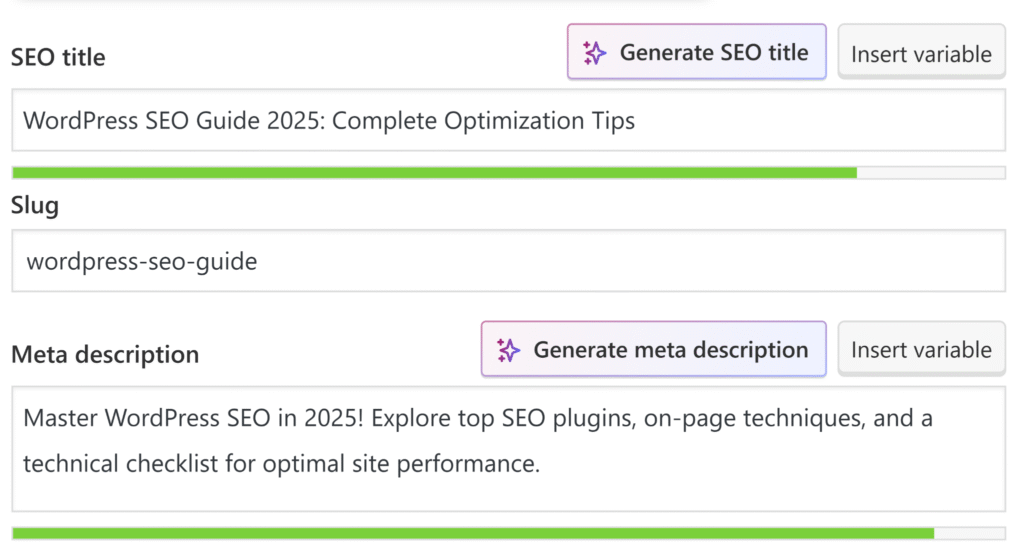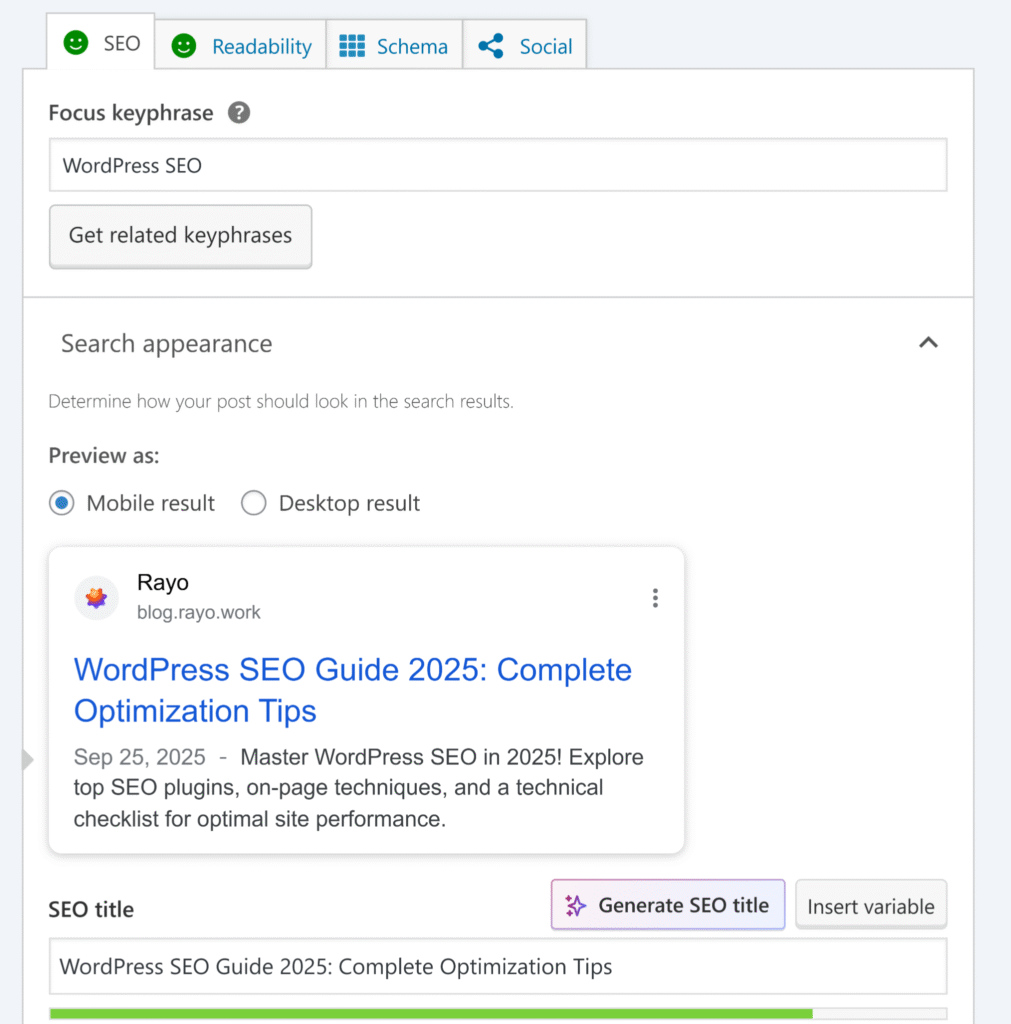Keeping up with WordPress SEO can feel like chasing a moving target. As we look ahead to 2025, search engine algorithms continue to evolve, making it crucial for website owners to adapt their optimization strategies. Whether you’re running a small blog or managing a large business site, implementing the right SEO techniques on your WordPress platform can dramatically impact your visibility in search results.
The good news? WordPress offers incredible flexibility for SEO optimization. Let’s dive into actionable strategies that will position your WordPress site for search success in 2025 and beyond.
Set up WordPress for SEO
Update site visibility settings
Before diving into complex SEO tactics, check your site’s basic visibility settings. In your WordPress dashboard, go to Settings > Reading and make sure the “Discourage search engines from indexing this site” option is unchecked. It’s surprisingly common to leave this box checked during development and forget to update it when launching – instantly making your site invisible to search engines!
- Navigate to Settings > Reading
- Look for “Search Engine Visibility”
- Ensure the checkbox is unchecked to allow indexing
Set preferred domain version
Search engines view “www.yoursite.com” and “yoursite.com” as two separate websites. To avoid diluting your SEO efforts, choose one version as your canonical domain. The easiest way to handle this is through your WordPress settings and hosting configuration:
- Update your WordPress Address and Site Address in Settings > General
- Set up 301 redirects from your non-preferred version to your preferred domain
- Configure this in your .htaccess file or through your hosting dashboard
Pick SEO-optimized permalinks
Your URL structure significantly impacts search visibility. Under Settings > Permalinks, choose a structure that includes relevant keywords. The “Post name” option is typically best for SEO, creating clean URLs like “yourwebsite.com/post-title” instead of cryptic strings of numbers and characters.
For even better results, customize your permalinks further by:
- Keeping URLs short and descriptive
- Including your target keyword near the beginning
- Using hyphens (not underscores) to separate words
- Avoiding stop words (a, the, and, etc.) when possible
Install essential SEO plugins
WordPress plugins add powerful SEO functionality to your site. While we’ll discuss specific plugins in depth later, here are the essential types you should install immediately:
- All-in-one SEO plugin: Yoast SEO, Rank Math, or All in One SEO Pack
- Caching plugin: WP Rocket, W3 Total Cache, or LiteSpeed Cache
- Image optimizer: Smush, EWWW Image Optimizer, or ShortPixel
Technical SEO for WordPress
Mobile Optimization
With mobile-first indexing fully implemented by Google, your site must perform flawlessly on smartphones and tablets. Beyond choosing a responsive theme, take these additional steps:
- Test your site using Google’s Mobile-Friendly Test tool
- Ensure tap targets (buttons, links) are properly sized and spaced
- Verify text is readable without zooming
- Check that images and videos scale correctly
- Remove any mobile-blocking resources (like Flash)
Site Speed and Performance
Page speed has become a critical ranking factor, especially with Core Web Vitals now firmly established as a ranking signal. Optimize your WordPress site by:

- Enabling browser caching and GZIP compression
- Compressing and lazy-loading images
- Minimizing HTTP requests
- Using a content delivery network (CDN)
- Limiting plugins to only those you truly need
- Upgrading to PHP 8.1+ for better performance
XML Sitemaps and Robots.txt
Help search engines efficiently crawl your site with properly configured XML sitemaps and robots.txt files:
XML Sitemaps: Most SEO plugins generate these automatically. Ensure yours includes all important pages while excluding thin content. Once created, submit your sitemap to Google Search Console and Bing Webmaster Tools.
Robots.txt: This file tells search engines which parts of your site they shouldn’t crawl. Common examples of pages to exclude include:
- Admin pages
- Thank you pages
- Duplicate content areas
- Private member sections
Apply key On-page SEO techniques
Craft SEO-friendly titles and meta descriptions
Your page titles and meta descriptions serve as advertisements in search results. Create compelling titles that:
- Include your target keyword near the beginning
- Stay under 60 characters to avoid truncation
- Use power words that drive clicks
- Include your brand name at the end for recognition

For meta descriptions:
- Keep them between 120-155 characters
- Include a clear call to action
- Incorporate your primary and secondary keywords naturally
- Address the searcher’s intent directly
Use keyword-rich headings and subheadings
Structure your content with semantic headings (H1, H2, H3, etc.) that incorporate relevant keywords. This helps both readers and search engines understand your content hierarchy. Your H1 should contain your primary keyword, while H2s and H3s can target secondary and long-tail variations.
Optimize content with relevant internal links
Strategic internal linking distributes page authority throughout your site and helps search engines discover and understand your content. For effective internal linking:
- Link to related content from within your posts
- Use descriptive anchor text that includes relevant keywords
- Create pillar content that links to more specific topics
- Update older content with links to newer, related posts
Write clean, responsive, fast-loading HTML
Clean code improves crawlability and site performance. Improve your WordPress HTML by:
- Validating your HTML with W3C’s validator tool
- Removing unnecessary markup and inline styles
- Using semantic HTML5 elements (article, section, nav)
- Adding schema markup for enhanced search results
Use the best WordPress SEO plugins
How to use the Yoast SEO plugin for content?

Yoast SEO remains one of the most popular WordPress SEO plugins, offering robust content analysis. To get the most from Yoast:
- Fill out the focus keyphrase field for each post
- Aim for green bullets in the content analysis
- Customize your title and meta description templates
- Enable breadcrumbs for improved site structure
- Connect to Google Search Console for performance insights
Leverage Rank Math for advanced schema
Rank Math has gained popularity for its comprehensive features, especially its schema implementation. With Rank Math, you can:
- Add multiple focus keywords per post
- Implement advanced schema markup with a few clicks
- Track keyword positions directly in your dashboard
- Get AI-powered content suggestions
Track performance with All in One SEO
All in One SEO Pack offers excellent analytics integration, allowing you to:
- Monitor your performance metrics directly in WordPress
- Track keyword rankings and search visibility
- Get actionable recommendations to improve underperforming pages
- Identify content gaps based on search queries
Combine plugins with manual SEO wins
While plugins provide valuable automation, don’t rely on them exclusively. Blend automated tools with manual optimization:
- Regularly audit your content for opportunities to improve
- Look beyond the plugin’s suggestions to industry-specific optimizations
- Manually check for technical issues plugins might miss
- Create content that serves users first, algorithms second
Bring it all together for 2025 SEO success
WordPress SEO in 2025 requires a holistic approach. The most successful sites will combine technical excellence with outstanding content that truly serves user needs. Start with the fundamentals: proper settings, optimized structure, and fast performance. Then layer on content optimization and leverage the right plugins to streamline your workflow.
Remember that SEO is an ongoing process, not a one-time task. Regularly monitor your performance, stay updated on algorithm changes, and continuously refine your approach. By implementing the strategies in this guide, you’ll build a strong foundation for WordPress SEO success that will serve your site well into 2025 and beyond.
Frequently Asked Questions
What are the best SEO plugins for WordPress in 2025?
The top WordPress SEO plugins for 2025 include Yoast SEO, Rank Math, and All in One SEO Pack. Yoast remains popular for its user-friendly content analysis, while Rank Math offers more advanced features like multiple focus keywords and extensive schema options. All in One SEO excels at performance tracking and analytics integration. The “best” plugin depends on your specific needs – many site owners use Yoast for its simplicity, while more technical users often prefer Rank Math’s advanced capabilities.
How do I use Yoast SEO to improve rankings?
To maximize Yoast SEO’s impact on your rankings, start by properly configuring the plugin’s global settings, including your site representation (person or company) and social profiles. For each post, enter your focus keyword and follow Yoast’s content analysis suggestions to improve readability and SEO. Customize your meta descriptions and titles rather than using the auto-generated versions. Enable and configure additional features like XML sitemaps, breadcrumbs, and schema markup. Finally, connect Yoast to Google Search Console to identify and fix indexing issues.
Can WordPress SEO themes boost Core Web Vitals?
Yes, WordPress SEO themes can significantly improve your Core Web Vitals scores. Modern SEO-focused themes are built with performance in mind, featuring optimized code, reduced JavaScript, and efficient CSS loading patterns. Themes like Astra, GeneratePress, and Kadence are specifically designed to score well on Core Web Vitals metrics like Largest Contentful Paint (LCP), First Input Delay (FID), and Cumulative Layout Shift (CLS). However, even the best theme requires proper configuration – you’ll still need to optimize images, implement caching, and minimize plugin bloat to achieve top performance scores.

Ridam Khare is an SEO strategist with 7+ years of experience specializing in AI-driven content creation. He helps businesses scale high-quality blogs that rank, engage, and convert.



